2.4-2.5
1/42
There's no tags or description
Looks like no tags are added yet.
Name | Mastery | Learn | Test | Matching | Spaced |
|---|
No study sessions yet.
43 Terms
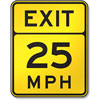
Advisory Speed - indicates the maximum safe speed for a highway exit
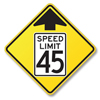
Reduced Speed Limit Ahead: Prepare to reduce your speed; the speed limit is changing ahead.

Stop Ahead/Yield Ahead: A stop sign or yield sign is ahead. Slow down and be ready to stop.
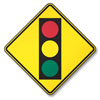
Signal Ahead: Traffic signals are ahead. Slow down and be ready to stop.
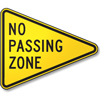
No Passing Zone:
This sign marks the beginning of a no-passing zone. You may not pass cars ahead of you in your lane, even if the way is clear.
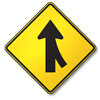
Merge: Two lanes of traffic moving in the same direction are about to become one. Drivers in both lanes are responsible for merging safely.

Lane Reduction: The right lane ends soon. Drivers in the right lane must merge left when space opens up. Drivers in the left lane should allow other vehicles to merge smoothly.
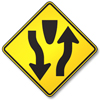
Divided Highway Begins: The highway ahead is split into two separate roadways by a median or divider and each roadway is one-way. Keep right.
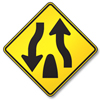
Divided Highway Ends: The highway ahead no longer has a median or divider. Traffic goes in both directions. Keep right.
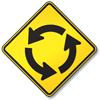
Roundabout: A circular intersection with an island in the center. Entering traffic must yield to vehicles already in the roundabout and travel counterclockwise.
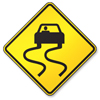
Slippery When Wet: When pavement is wet, reduce your speed. Do not brake hard or change direction suddenly. Increase the distance between your car and the one ahead of you.
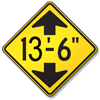
Low Clearance Sign: The overpass ahead has a low clearance. Do not proceed if your vehicle is taller than the height shown on the sign.
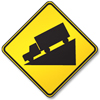
Hill: A steep grade is ahead. Check your brakes.
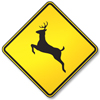
Deer Crossing: Deer cross the roadway in this area. Slow down, be alert and be ready to stop.
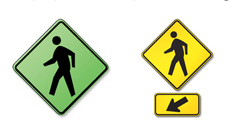
Pedestrian Crossing: Watch for people entering a crosswalk or crossing your path. Slow down and be prepared to stop. A second sign with an arrow may show the actual location of the crosswalk.
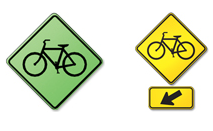
Bicycle Crossing/Bike Path: Bicycles regularly cross or ride beside traffic in this area. Drive with caution. A second sign with an arrow may show the actual location of the bike crossing.
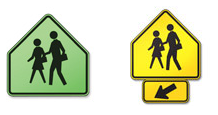
School Zone/School Crossing: Watch for children crossing or playing. Slow down, obey signals, and follow crossing guard instructions. A second sign with an arrow may indicate the sidewalk location.
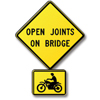
Open Joints: Slow down. Open joints on bridges or ramps could cause a motorcyclist to lose control of the motorcycle.
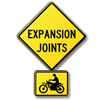
Expansion Joints: This sign is used when a joint across lanes creates a bump or is wide enough to cause loss of traction in wet weather.
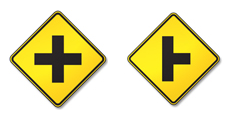
Intersections: An intersection is ahead. Be alert for vehicles entering the road on which you are traveling. (cross & side road)
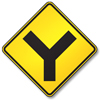
Y Intersection: You must bear either right or left ahead.
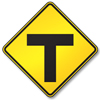
T Intersection: The roadway you are traveling on ends ahead at a stop sign. You must turn right or left after yielding to oncoming traffic and pedestrians
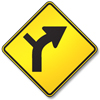
Right Curve – Side Road: The road ahead curves right and a side road joins from the left within the curve. Be alert for vehicles entering the roadway you are traveling on.
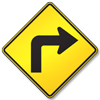
Sharp Right Turn: Slow down and be prepared for a sharp right turn in the road ahead.
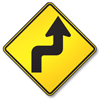
Sharp Right and Left Turns: Slow down and be prepared for the road ahead to turn sharply right, then left.
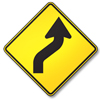
Right and Left Curves: The road ahead curves right, then left. Slow down.
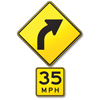
Right Curve with Safe Speed Indicator: The road ahead curves right. Slow down to the safe speed indicated.
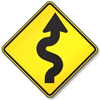
Winding Road: The road ahead winds with a series of turns or curves. On all curves, slow down for better control.

Low Ground Railroad Crossing: A steep slope where the railroad tracks cross the road may cause the bottom of low vehicles to get caught or drag on the tracks.
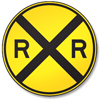
Low Ground Railroad Crossing: A steep slope where the railroad tracks cross the road may cause the bottom of low vehicles to get caught or drag on the tracks.
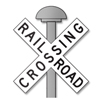
Railroad Crossbuck: A railroad crossing is ahead. Look, listen, and slow down. Be prepared to stop for approaching trains from either direction.
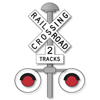
Railroad Crossbuck and Flashing Lights: Stop when the lights begin to flash. Wait until all trains or other rail vehicles have passed, and the lights stop flashing before proceeding. Be especially alert at multi-track crossings because a second train could be approaching from the opposite direction.
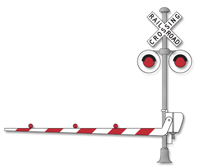
Crossbuck, Flashing Lights and Gate: Stop when the lights flash and before the gate lowers. Remain stopped until the gate fully rises and lights stop flashing. Never drive around a lowered gate.
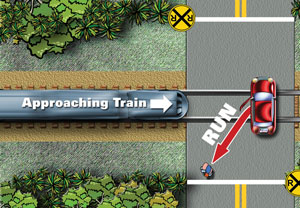
If your car stalls on the tracks, don't hesitate. Get out of the car right away and run diagonally away from the tracks in the direction of the oncoming train.

Rough Road, Bump, or Uneven Lanes:
These signs are used when certain road conditions, such as loose gravel or road construction, affect the roadway surface and create potentially difficult conditions for motorists, especially motorcyclists.
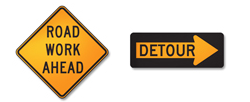
Road Construction Ahead , Detour:
These signs indicate a change in the traffic pattern or route ahead. Slow down. Unusual or potentially dangerous conditions are ahead.

Flashing Arrow Boards:
Large flashing arrow boards/flashing message signs in work zones direct drivers into different lanes and indicate road closures ahead.
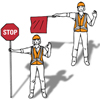
Flaggers:
Flaggers are highway workers who normally wear orange or yellow vests, or yellow-green shirts or jackets. They use STOP/SLOW paddles or red flags to stop or direct traffic through the work zone and to let other workers or construction vehicles cross the road.
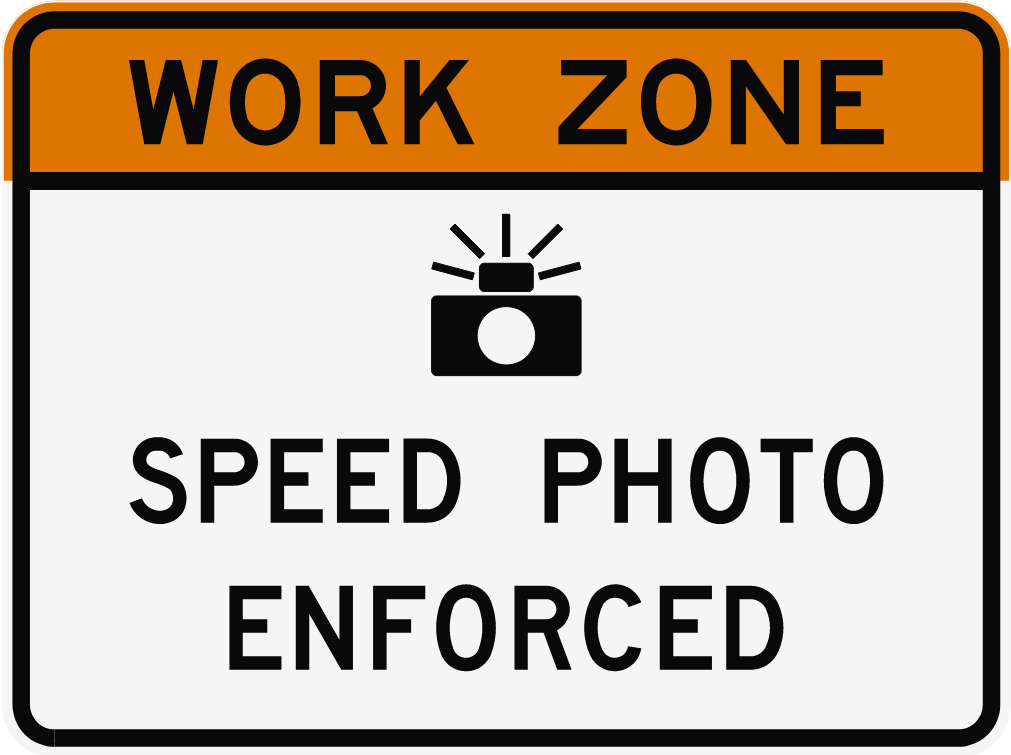
Photo Speed Enforcement:
This sign indicates that automated photo enforcement is in place for speeding in a work zone. Always obey the posted speed limit in a work zone.
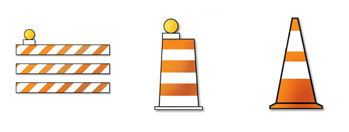
Traffic Control Devices:
Barricades, vertical signs, drums, cones, and barriers are standard guides to traffic safety. Stay centered in your lane and obey the speed limit. Do not change lanes until completely clear of the work zone.
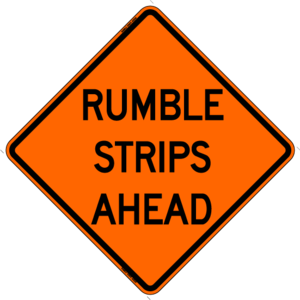
Rumble Strips Ahead
Black or orange strips warn of upcoming flaggers or lane closures. Drive over them slowly—do not swerve around them.
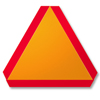
Slowing Moving Vehicles
Vehicles traveling 25 mph or less (e.g., farm equipment, horse-drawn vehicles, highway work vehicles) must display this sign on public highways. Be prepared to slow down or adjust your position.
If you are convicted of exceeding the speed limit in a highway work zone, you may be fined up to-
$500. Remember, the color orange marks a work zone and means slow down and be alert.